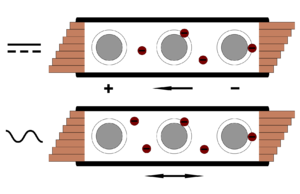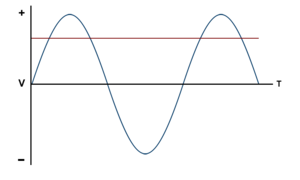Electricity types
There are two types of electricity – alternating Current (AC) and direct Current (DC). These two terms describe the way in which the current flows in a circuit. In a DC circuit, the current only flows in one direction, meaning that this type of circuit has a positive (+) and negative (-) that do not change. This relationship of positive to negative charge is referred to as polarity. In an alternating current circuit, current flow changes direction regularly, switching the polarity (positive (+) and negative (-)) each time. This switching back-and-forth of polarity in an alternating current circuit is referred to as frequency and is measured in Hertz (Hz). Polarity in a typical AC circuit switches between 50-60 times per second meaning that the circuit has a frequency of 50-60 Hz.
Nominal voltage and frequency
In any electrical system, whether AC or DC, all components or appliances must be rated to function with the characteristics of the electrical system - voltage, current, and frequency if AC. If they are used improperly it can lead to a failure that results in fire or injury. For DC components this will likely be 12 V, 24 V, or 48 V. AC component voltages vary significantly by country, but common ratings are 120 V, 220 V, 240 V. Common AC frequencies are 50 or 60 Hz. These ratings are called nominal voltage or nominal frequency as no electrical system is able to operate at all times at an exact value, especially stand-alone PV systems which have a highly variable form of power generation and a storage system with a voltage that will sag under heavy loads or when low on energy. Therefore all components made for use with an electrical system accept a range of voltages and frequencies that should work with other components or systems that share that similar rating (some accept smaller or larger ranges than others).
Direct current
PV modules can only produce DC, thus all PV systems have at least one DC circuit. Anything that uses a battery, including PV systems, will be based on DC as batteries can only store energy in DC form. Powering a load directly from DC saves the step of having to use an inverter to convert from DC to AC, which can create losses of more than 10% in the process. Many small scall systems are DC only and work well for lightning and the charging of small electronic devices like cell phones.
Alternating current
In alternating current (AC) circuits the voltage goes through a cycle as positive and negative change many times each second, which causes the current to change its direction of flow. The voltage of an AC circuit can be represented as a wave on a graph (the graphic at right depicts on full AC cycle). It is important to note that when measuring the voltage of AC circuits with a multimeter the reading will always appear positive because it is calculated using a method called root mean square that results in negative values being treated as positive values in order to be able to create a comparison to DC. The brief negative cycles are included into this calculation. The voltage during one of these cycles can be graphically depicted as a sine wave for off-grid PVs systems that have a pure sine wave inverter.
The grid is almost entirely built to function with alternating current, although the voltage, frequency and number of wires in a supply circuit varies around the world. Nearly all electronic devices - cell phones, radios, computers and televisions - run on DC internally, but they incorporate electronics to convert from AC to DC in order to function with the grid. Appliances with motors or compressors - refrigerators, fans, and tools - have motors that can run directly on alternating current. Most countries use different voltages for different service types (residential, commercial, industrial). Some countries also have voltages and frequencies that vary based upon location as the grid has not been standardized. The wiring configuration - two-wire single phase (L1, N), three-wire single phase (L1, L2, N), three phase (L1, L2, L3) - can vary for the same voltage from country-to-country as well. Three phase services are typically used for commercial and industrial applications as they run motors more smoothly and can supply more current at the same voltage compared to non-three phase services. See Special:MyLanguage/Voltage and frequency by country for the voltage and frequency for specific countries.
AC or DC?
If so many appliances internally function on DC, why not just use direct current for every circuit then? Because each type of current has different characteristics that make it useful for certain applications. AC has important properties that make it useful in the electrical grid. It is cheaper to transmit AC over long distances as it is easier to change between high and low voltages. High voltages are ideal for long distance transmission as they require less current, which means you can use smaller wires. DC works well in off-grid applications as PV modules produce DC and batteries store energy in DC, meaning that using AC appliances requires the added expense and loss of efficiency that come with an inverter.

